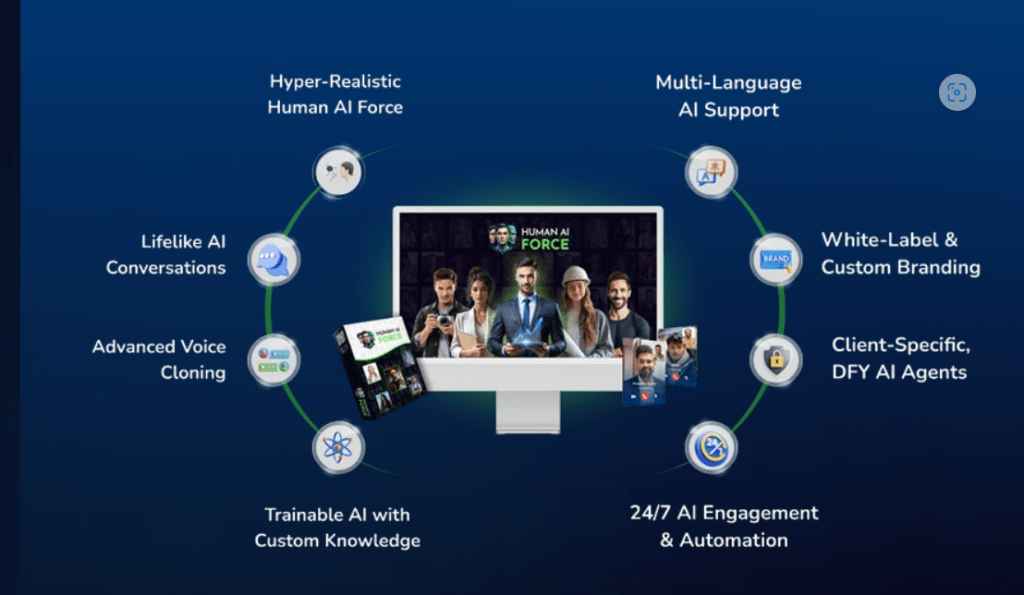Introduction
The rapid evolution of artificial intelligence (AI) has sparked discussions about its potential to replace human labor. However, the true power of AI lies not in replacing humans but in augmenting and enhancing human capabilities. The concept of Human-AI Force represents a new paradigm where human intelligence and artificial intelligence work together symbiotically to achieve greater efficiency, innovation, and problem-solving capabilities across industries.
Understanding Human-AI Force
Human-AI Force refers to the collaboration between human expertise and AI-driven automation to optimize performance in various fields. Unlike the traditional notion of AI as an independent entity, this concept emphasizes AI as a partner, assisting humans in making better decisions, automating routine tasks, and generating insights from vast amounts of data.
Get more details click here

Key Components of Human-AI Force
- Augmented Decision-Making
AI provides data-driven recommendations, while humans contribute creativity, intuition, and ethical considerations. This synergy leads to more informed and balanced decision-making. - Automation with Human Oversight
AI automates repetitive tasks, reducing workload and allowing humans to focus on strategic and creative aspects of work. - Continuous Learning and Adaptation
Humans and AI learn from each other, continuously refining algorithms and improving performance based on real-world experiences. - Ethical and Responsible AI Use
Human oversight ensures AI systems operate within ethical and regulatory boundaries, minimizing biases and ensuring fairness.
Applications of Human-AI Force
1. Healthcare
AI-powered diagnostic tools assist doctors in identifying diseases with greater accuracy. Surgeons use robotic assistance for precision procedures, while AI streamlines patient care and administrative tasks.
2. Business and Finance
AI analyzes market trends and predicts financial risks, allowing businesses to make smarter investment decisions. AI-driven chatbots and customer service solutions enhance user experience, reducing response times and improving service quality.
3. Manufacturing and Automation
Smart factories integrate AI with human labor to improve productivity and reduce errors. AI-powered robots handle repetitive assembly-line tasks while human workers oversee quality control and innovation.
4. Education and Learning
AI-driven personalized learning platforms adapt to students’ needs, providing tailored educational experiences. Teachers leverage AI insights to enhance curriculum effectiveness and student engagement.
5. Creative Industries
AI assists artists, musicians, and writers in generating new ideas, enhancing creativity rather than replacing it. Tools like AI-generated music, automated design software, and language models support creative professionals in producing high-quality content.

The Future of Human-AI Collaboration
The rise of Human-AI Force signifies a shift from competition to collaboration. The future will see AI evolving as a co-worker, assistant, and creative partner rather than a mere tool. As AI capabilities grow, ethical considerations, transparency, and regulatory frameworks will play a crucial role in ensuring a harmonious and productive partnership between humans and machines.
Challenges and Considerations
Despite the promising potential of Human-AI collaboration, several challenges must be addressed to ensure a smooth integration:
- Bias and Fairness
AI systems can inadvertently inherit biases from training data, leading to unfair outcomes. Ensuring diverse and unbiased data sets, along with human oversight, is critical. - Job Displacement Concerns
While AI enhances productivity, there is a fear of job loss. Reskilling and upskilling programs should be implemented to help workers transition into roles that leverage human creativity and AI capabilities. - Data Privacy and Security
AI relies on vast amounts of data, raising concerns about privacy and security. Organizations must establish strong policies and encryption measures to protect sensitive information. - Trust and Transparency
Users must trust AI systems to make fair and accurate decisions. Transparent AI models and explainable AI (XAI) frameworks can help build confidence in AI-driven processes.

Conclusion
The Human-AI Force is not about replacing human intelligence but amplifying it. By leveraging the strengths of both humans and AI, industries can unlock new levels of innovation, efficiency, and problem-solving. The key to success lies in fostering an ecosystem where AI empowers humans, leading to a smarter and more sustainable future. With proper implementation, ethical considerations, and continuous learning, the synergy between humans and AI will shape a more advanced and inclusive world.

